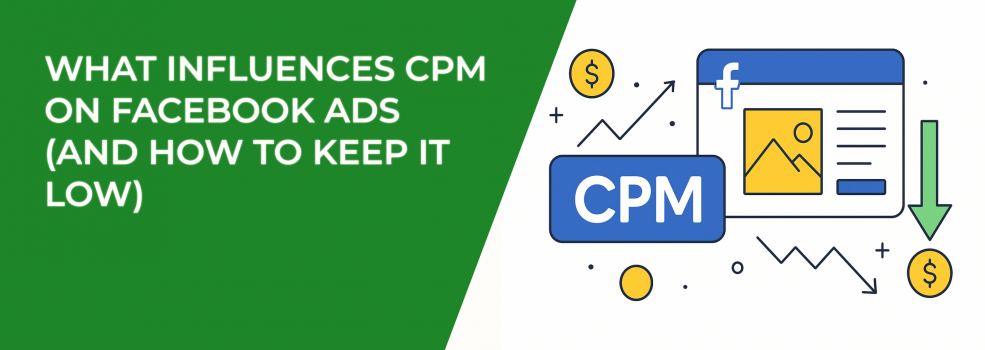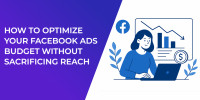Why do Facebook ad costs suddenly go up even when everything in your campaign looks the same?
If you’ve been running ads for a while, you’ve probably seen your CPM (cost per 1,000 impressions) spike out of nowhere. This can be frustrating, especially when your click-through rate or conversions don’t seem to be the issue.
Understanding what influences CPM on Facebook Ads can help you take control and reduce your costs. In this article, we’ll break down the main factors behind high CPM and share proven strategies to help you keep it low and your results strong.
What Is CPM in Facebook Ads?
CPM stands for “Cost Per Mille,” which is the amount you pay to show your ad 1,000 times on Facebook or Instagram. It’s one of the core pricing metrics on Meta’s ad platform.
While CPM doesn’t measure direct actions like clicks or conversions, it shows how expensive it is to get your ad in front of people.
CPM has a tendency to rise with time (unless you take proactive steps to prevent it).
A high CPM often means you’re paying more just to be seen which can eat into your results fast. Keeping your CPM low means better reach for your budget and more opportunities to drive engagement, traffic, or sales.
What Affects CPM for Facebook Ads?
Several factors influence your Facebook ad CPM. Let’s take a closer look at what causes it to rise and what you can do to control it.
1. Audience Size and Competition
The more advertisers targeting the same group, the more expensive it becomes. Facebook ads run through an auction system — and when demand goes up, so does cost.
For example, targeting a popular segment like women aged 25-35 who are interested in skincare puts you in direct competition with hundreds (if not thousands) of other brands. That drives CPM up.
Depending on your industry and campaign objective, some audiences might give you higher CPMs, some lower. Testing different audiences is essential to discover your optimal CPM levels.
To lower CPM:
-
Test different audience combinations;
-
Use lookalike audiences or custom audiences;
-
Avoid overly broad or highly saturated segments.
Facebook performs best with audiences that are well-defined, but not so narrow that the algorithm struggles to find users.
Want a deeper understanding Facebook ad targeting? Don’t miss our guide Facebook ad targeting 101: how to reach the right audience.
2. Seasonality and Ad Timing
Your CPM often changes depending on when you run your ads.
During high-competition periods like Black Friday, Christmas, or Valentine’s Day, CPMs can rise sharply. Everyone is fighting for the same attention — and Facebook charges more simply because demand is higher.
Even outside of holidays, CPM can spike during elections, product launches, or trending events that shift user behavior.
What can you do?
-
Monitor industry trends and seasonal traffic;
-
Launch campaigns earlier to avoid high-traffic bidding periods;
-
Shift ad spend to quieter, lower-cost windows when possible.
Planning around key dates can make your budget work harder.
3. Ad Relevance and Creative Quality
Facebook rewards high-quality ads with better placement and lower CPMs. If your ad is engaging, loads quickly, and resonates with users, you’ll likely pay less per impression.
But if users scroll past it or worse, hide or report it, your CPM goes up.
Higher creative scores often lead to lower CPMs for Facebook ads.
To improve ad performance:
-
Use clear, scroll-stopping visuals or video;
-
Keep your messaging short, focused, and benefit-driven;
-
Test different creative versions to find what resonates;
-
Optimize for fast load times, especially on mobile.
Good creative isn’t just about design — it’s about relevance. The more relevant your ads, the more efficient your campaigns.
If you’re using AI tools to help with ad creation, be sure you’re choosing the right ones — check out the best AI text and image generators for tested recommendations.
4. Frequency and Audience Fatigue
When people see your ad too often, they stop engaging. This lowers your relevance score and pushes your CPM higher. The issue? You may not notice it right away.
If your frequency metric creeps up above 3 or 4 and your results start to decline, you’re probably facing audience fatigue.
To keep engagement high:
-
Monitor your frequency metrics weekly;
-
Refresh creatives every 10 to 14 days;
-
Rotate headlines, visuals, and offers;
-
Expand or segment your audiences to reduce repetition.
Refreshing your approach keeps your audience interested and your costs lower.
If you're seeing high frequency and poor engagement, you're likely dealing with ad fatigue. Learn how to spot and fix it fast in our article about ad fatigue on Facebook.
5. Campaign Objective and Optimization Settings
Your campaign objective plays a big role in CPM. For example, brand awareness campaigns often have lower CPMs than conversion campaigns because they’re easier to deliver.
But lower cost doesn’t always mean better performance. If your true goal is sales or leads, you’ll want to optimize for that, even if the CPM is higher.
To optimize effectively:
-
Choose the right objective for your actual goal;
-
If conversions are too expensive, test intermediate events like “Add to Cart” or “Landing Page Views”;
-
Ensure your pixel or event tracking is fully set up and accurate.
When Facebook knows what to optimize for and has good data to work with, your ads become more cost-efficient over time.
Not sure which campaign objective to choose? This guide to Meta ad campaign objectives will help you select the right one based on your goals.
How to Keep Facebook Ads CPM Low
Now that you know what drives CPM, here are some practical tips to help you lower it without sacrificing performance.
1. Fine-Tune Your Targeting
-
Avoid extremely broad audiences, especially in competitive industries;
-
Use lookalike audiences based on real customer data;
-
Combine interest and behavior filters to create high-intent segments;
-
Build custom audiences using LeadEnforce to target users who follow your competitors or niche Facebook groups and Instagram accounts.
Smarter targeting helps you avoid bidding against too many advertisers and reduces wasted impressions. And tools like LeadEnforce give you access to unique, behavior-based audiences that Meta’s default options often miss, helping you reach the right people, at the right time, with less competition. You can learn more in our article how to build your target audience from a Facebook group.
2. Improve and Rotate Your Creatives
-
Use a mix of ad formats like carousel, video, and Reels;
-
Refresh ad visuals and copy every two to three weeks;
-
Align your creative with your audience’s specific interests and pain points.
Even small creative tweaks can help reduce fatigue and keep CPM low.
3. Avoid Bidding During Peak Times
-
Schedule ads outside major holidays when possible;
-
Run campaigns mid-week or mid-month, when competition is typically lower;
-
Shift budget to off-peak periods for better cost-efficiency.
Timing your ads strategically helps stretch your budget, especially if you’re working with limited spend.
4. Monitor and Adjust Regularly
-
Keep a close eye on your CPM trends and frequency;
-
Run A/B tests to compare different creatives, placements, or bidding strategies;
-
Adjust quickly when you see performance drop or costs rise.
Regular optimization is key. Small changes often deliver big results when it comes to lowering Facebook ad costs.
Final Thoughts
Your CPM isn’t random. It’s shaped by your audience targeting, timing, creative quality, optimization strategy, and more.
The good news? Most of these factors are within your control.
By refining your targeting, improving creative, staying ahead of fatigue, and tracking performance closely, you can keep CPM low and get more value from every dollar you spend.

